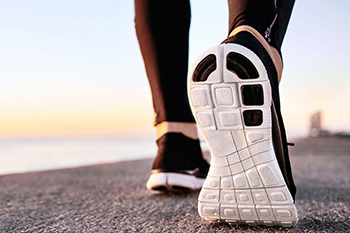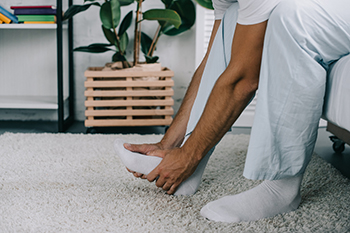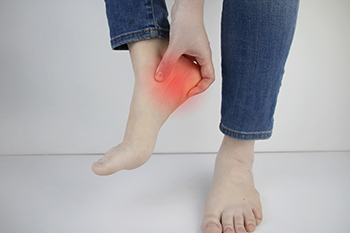
Drexel Hill (484) 521-0233
West Chester (610) 436-5883

Drexel Hill (484) 521-0233
West Chester (610) 436-5883

People that have fitness goals realize getting injured can be a huge setback and will disrupt completing goals on time. Preventing running injuries is an integral part of staying fit and healthy, and there are simple methods that can be implemented to accomplish this. It is important to take a day off from your chosen sport as this can give the body ample time to rest. When the training is intense, it is beneficial to follow an easier workout the next day, allowing the legs and body to recover. Research has indicated how important sleep is for physically fit individuals and cardiovascular performance may be hindered if sleep is deprived on a routine basis. Warming up and cooling down is an essential part of any workout routine because it provides the muscles with increased blood flow, in addition to alleviating muscle stiffness. There are several ways running injuries can affect the feet so it is suggested that you confer with a podiatrist who can guide you on additional methods for how to prevent them.
All runners should take extra precaution when trying to avoid injury. If you have any concerns about your feet, contact the podiatrists of Dr. Siegerman & Associates. Our doctors will treat your foot and ankle needs.
How to Prevent Running Injuries
There are a lot of mistakes a runner can make prior to a workout that can induce injury. A lot of athletes tend to overstretch before running, instead of saving those workouts for a post-run routine. Deep lunges and hand-to-toe hamstring pulls should be performed after a workout instead of during a warmup. Another common mistake is jumping into an intense routine before your body is physically prepared for it. You should try to ease your way into long-distance running instead of forcing yourself to rush into it.
More Tips for Preventing Injury
If you have any questions, please feel free to contact one of our offices located in Drexel Hill and West Chester, PA . We offer the newest diagnostic and treatment technologies for all your foot care needs.

The movements that are done by walking and running are very different. People who enjoy running will often buy shoes that are different from those who like to walk. One of the main differences between these two types of shoes is the soles. Running shoes have a thicker heel area and a stiffer sole, which provides adequate stability while remaining lightweight. In comparison, walking shoes have a sole that is flexible and heels that are heavier. The materials that comprise running shoes are made of breathable fabrics, and this is to accommodate sweaty feet that can occur while running. Substantial material is often used when constructing walking shoes, and the heel is tilted so the feet can retain an angle while landing on the ground. Extra padding can be found in running shoes, despite being lighter in weight than most other footwear. If you are interested in pursuing walking or running as a sport or hobby, it is strongly advised that you consult with a podiatrist who can guide you toward what type of shoes to purchase.
For more information about walking shoes versus running shoes, consult with the podiatrists from Dr. Siegerman & Associates. Our doctors can measure your feet to determine what your needs are and help you find an appropriate pair of footwear.
Foot Health: The Differences between Walking & Running Shoes
There are great ways to stay in shape: running and walking are two great exercises to a healthy lifestyle. It is important to know that running shoes and walking shoes are not interchangeable. There is a key difference on how the feet hit the ground when someone is running or walking. This is why one should be aware that a shoe is designed differently for each activity.
You may be asking yourself what the real differences are between walking and running shoes and the answers may shock you.
Differences
Walking doesn’t involve as much stress or impact on the feet as running does. However, this doesn’t mean that you should be any less prepared. When you’re walking, you land on your heels and have your foot roll forward. This rolling motion requires additional support to the feet.
Flexibility – Walking shoes are designed to have soft, flexible soles. This allows the walker to push off easily with each step.
If you have any questions, please feel free to contact one of our offices located in Drexel Hill and West Chester, PA . We offer the newest diagnostic and treatment technologies for all your foot care needs.

The feet are complex structures and foot pain may occur for various reasons. One common source of foot pain is known as foot tendonitis. It can happen as a result of an irritated or inflamed tendon and may gradually or suddenly appear. Many people who enjoy running may experience this type of foot pain and it can also occur in patients who stand for most of the day. Existing medical conditions can contribute to this type of tendonitis as well, including flat feet or high arches. Achilles tendonitis is another form of foot pain and symptoms can include stiffness and swelling at the bottom of the heel. The pain may be worse upon arising in the morning or after long periods of rest. This type of injury can occur from increasing speed and mileage too quickly while running and may be more common among those who run infrequently. There are several different types of foot pain and if you are experiencing discomfort, it is strongly urged that you seek the counsel of a podiatrist who can expertly diagnose and treat it.
Foot Pain
Foot pain can be extremely painful and debilitating. If you have a foot pain, consult with the podiatrists from Dr. Siegerman & Associates. Our doctors will assess your condition and provide you with quality foot and ankle treatment.
Causes
Foot pain is a very broad condition that could be caused by one or more ailments. The most common include:
Diagnosis
To figure out the cause of foot pain, podiatrists utilize several different methods. This can range from simple visual inspections and sensation tests to X-rays and MRI scans. Prior medical history, family medical history, and any recent physical traumatic events will all be taken into consideration for a proper diagnosis.
Treatment
Treatment depends upon the cause of the foot pain. Whether it is resting, staying off the foot, or having surgery; podiatrists have a number of treatment options available for foot pain.
If you have any questions, please feel free to contact one of our offices located in Drexel Hill and West Chester, PA . We offer the newest diagnostic and treatment technologies for all your foot care needs.

When the plantar fascia becomes inflamed, it may be indicative of a foot condition referred to as plantar fasciitis. Research has shown plantar fasciitis affects approximately 10% of the population worldwide, and often causes severe heel pain. The plantar fascia, found on the sole of the foot, is a band of tissue that connects the heel to the toes. Excessive running or wearing shoes that do not fit correctly may cause the plantar fascia to become inflamed. Additionally, plantar fasciitis may develop from standing on hard surfaces for most of the day, or if the tissue becomes overstretched. Relief may be found when specific stretches are performed and shoes that are worn that have adequate cushioning. In severe cases, surgery may be necessary to permanently repair the plantar fascia. In patients who are overweight, it is suggested that eating healthy foods can help to reduce the effect body’s weight has on the soles of the feet. If you have heel pain, it is strongly suggested that you schedule an appointment with a podiatrist as quickly as possible who can diagnose and treat plantar fasciitis.
Plantar fasciitis can be very painful and inconvenient. If you are experiencing heel pain or symptoms of plantar fasciitis, contact the podiatrists from Dr. Siegerman & Associates. Our doctors can provide the care you need to keep you pain-free and on your feet.
What Is Plantar Fasciitis?
Plantar fasciitis is the inflammation of the thick band of tissue that runs along the bottom of your foot, known as the plantar fascia, and causes mild to severe heel pain.
What Causes Plantar Fasciitis?
How Can It Be Treated?
While very treatable, plantar fasciitis is definitely not something that should be ignored. Especially in severe cases, speaking to your doctor right away is highly recommended to avoid complications and severe heel pain. Your podiatrist can work with you to provide the appropriate treatment options tailored to your condition.
If you have any questions please feel free to contact one of our offices located in Drexel Hill and West Chester, PA . We offer the newest diagnostic and treatment technologies for all your foot and ankle needs.
Request a free copy of
Laser Away Foot Pain!
today.
